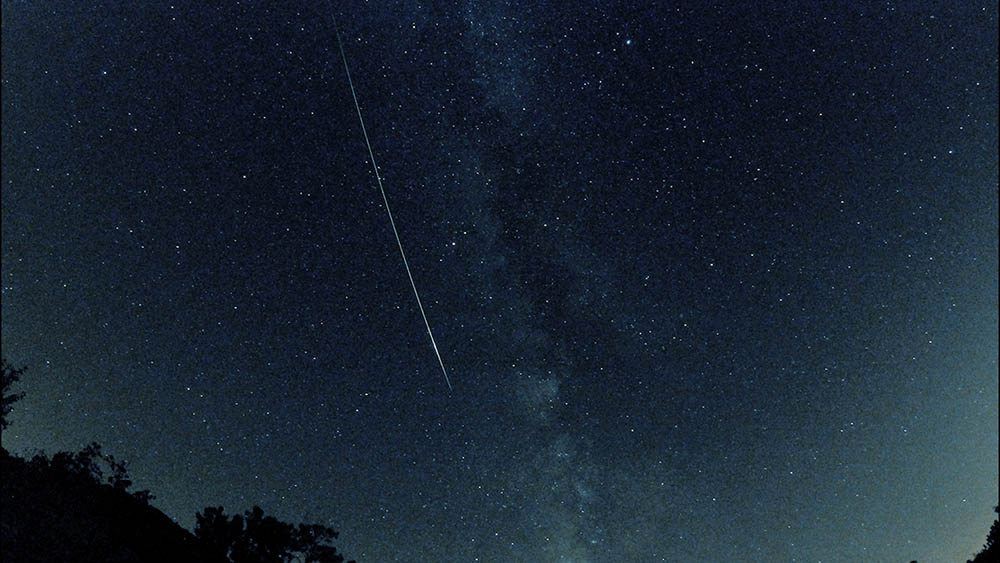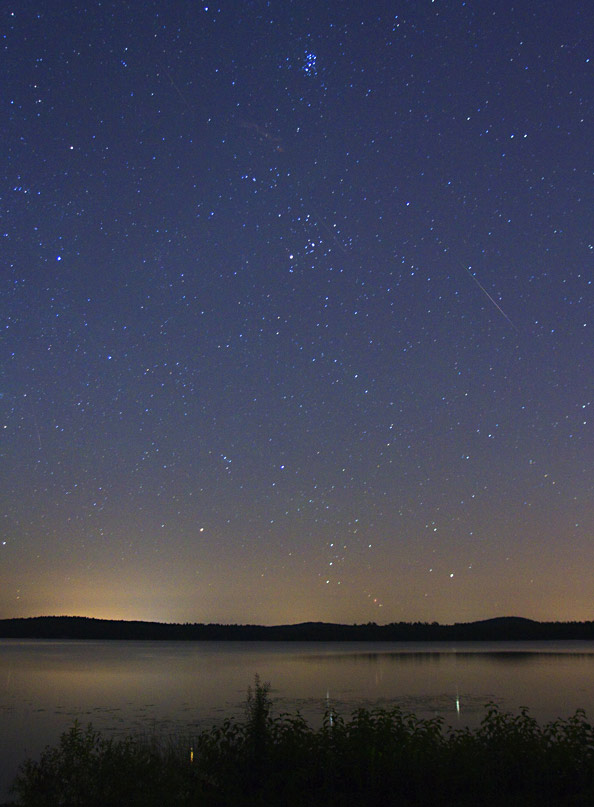Right on schedule, meteors bright and faint rewarded patient watchers on the shower's peak night. As a bunch of S&T editors can attest.
Many meteor showers are shy and fickle, but not the Perseids. They vie with the December Geminids for the title of the richest and most reliable of the year. Last night they came through again — if you were out late under a dark sky.

In the suburbs of Boston where I live, "dark" isn't really the word. But who's entitled to perfection? My wife Abby and I settled in for an hour of meteor watching starting at 3:03 a.m. EDT, me in my old reliable lawn chair in a winter coat, clipboard in hand. The sky was perfectly clear and, at that late hour, a little darker than usual. I counted stars in two of the International Meteor Organization's convenient standard areas and found my limiting magnitude to be 5.0 overhead, where I was watching. Pretty good! And as the hour wore on and the Pleiades climbed the east, I counted eight Pleiades instead of my usual six.
And the meteors! We saw faint little zips and an occasional big, bold blaze that left a briefly glowing train. In 64 minutes I counted 28 Perseids, 2 Kappa Cygnids (both nearly head-on, close to the radiant at the wingtip of Cygnus), 1 Delta Aquariid, and 2 sporadics.
My count ended at 4:07 when my cellphone rang. It was NPR's Morning Edition calling for a live, under-the-stars radio interview. I described the meteors, and the starry view, and the sailing satellites that almost outnumbered the meteors, and I rhapsodized about why we do amateur astronomy. Did anyone hear it? With the crickets and peepers in the background?
Here are some other Sky & Telescope editors' experiences.

Equipment Editor Sean Walker set up a camera by a lake in New Hampshire hoping to get lucky. Of the three fireballs he saw, none crossed his frames while the shutter was open. But he caught the twisted smoke-train aftermath of one, as well as four faint little zips. He combined them into the composite at right. He writes,
Skies were extremely clear and dry along the shore of Lake Massabesic in Auburn, New Hampshire, where I set up. I saw several dozen meteors in 2 hours between 2:30 and 4:30 a.m., when twilight began to brighten — including three very bright fireballs, one of which left a visible train between Taurus and Orion that lasted around 10 minutes.
Here is a composite photo of the four meteors I captured this morning as well as the “smoke” train. This is a composite of five separate 30-second photos taken with a Canon XS and 17-35mm f/2.8 lens, shot at ISO 1600.
Editor in Chief Peter Tyson watched from scenic Lincoln near its border with Concord, similar to my own distance from Boston:
As I lay on my back between 3 and 4 a.m. in a farm field near Walden Pond, I was channeling Henry David Thoreau. That is, I was taking in everything. Yes, I was watching the sky, but I was also keeping an eye on a patch of mist hugging the far end of the field to see if it would change in size or position. I was listening to the “invisible, incessant quire” of the crickets, whose songs Thoreau deemed “the very grain and stuff of which eternity is made.” I was assessing a faint aroma of manure, trying to determine if it was coming from a distant barn or from beneath my person. I was tasting the crisp, air, whose chill, enhanced by the dew-soaked grass I lay on, forced me to don a sweatshirt for the first time this summer.
As a result, whenever a meteor whipped past above, it caught me slightly off guard. Whoa, look at that! Fortunately, my eyes were in more or less the right place for the four best meteors, all of which left a smoky, fire-tinged afterglow for a second or two. With each I tried to get my head around the idea that that tiny object had been part of a comet drifting around the solar system for billions of years and only just this moment ended its age-old journey. I attempted to conjure what it would be like to streak alongside that streak, like Einstein imagined racing beside a light beam. (His thought experiment was a bit more fruitful than mine.) How many such meteors did Thoreau see, I wondered, perhaps from this very piece of land?
Altogether I caught sight of about 15 to 20 before the thought of how delicious more sleep would feel forced me to my feet and back to my car. It had been a satisfactory visual show, but coupled with the harvest from my other senses, it made for a truly delightful hour in Thoreau country.
This from Senior Editor J. Kelly Beatty:
We S&T editors always say the best way to see the Perseids is to get away from light pollution, and this year I took my own advice by going to a remote site in central Maine that boasts awesomely dark (6.4-magnitude) skies. Even better, I was surrounded by a dozen families who love stargazing too. Two rounds of early evening thunderstorms dampened the ground — but not our spirits. By 11 p.m. our observing area was cluttered with reclining chairs, and the air resonated with "oohs" and "ahhs" with each brilliant streak. Several fireballs showed a distinctive green, the telltale hue of nickel. This shower definitely lived up to its advance billing, and some of our group commented that it was the best display they'd ever seen — well, except for the 1998–99 Leonids!
Like many of you, web editor Monica Young got skunked:
My fail-safe technique for getting up in the early-morning hours (falling asleep on the couch) worked like a charm, and I got up at 12:30 a.m. The sky was crystal clear for about a minute and then this huge bank of clouds rolled in, and I gave up and went to bed.
But there's tonight! If the shower continues true to form it should still be at about half strength on Friday morning, and half on that on Saturday morning.
Here's the International Meteor Organization's activity curve for the ongoing Perseid shower, based on the incoming data that it has processed from observers as of when you click. My counts are in it!
 8
8









Comments
Monica Young
August 13, 2015 at 11:42 pm
Happy to report I was successful tonight! Crystal clear and saw several Perseids (though had to wait quite awhile), including one long, bright one.
You must be logged in to post a comment.
George Gliba
August 14, 2015 at 10:03 am
Screech Owl Hill Observatory, Mountain Meadows
Mathias, West Virginia - August 13, 2015
We had great conditions last night and may have caught the actual peak
as there were several fireballs seen from 7:00 to 7:42 UT of -5, -3, -4, and
-6 magnitudes. The last three were seen from 7:19 to 7:42 UT (23 minutes).
The -6 had a yellow-blue-green color and a long duration 40 second train!
I saw 82 Perseids the first hour and 81 the second hour. The ZHR must have
been near 90. The LM was around 6.6 for both hours. At the end of the second
session the Screech Owls became active. It was the best Perseids I have seen
since 1967 (in 48 years).
You must be logged in to post a comment.
George Gliba
August 14, 2015 at 11:29 am
Here is more specific detail on the individual meteors seen 8/13/15 from Mathias, WVa
Date Time (UT) LM %Obst. FOV
8/13/15 5:50-6:50 6.6 0% 2.0+63
KCG ANT SDA PAU PER ERI BPE SPO Total
0 3 1 0 82 1 1 7 95
Date Time (UT) LM %Obst. FOV
8/13/15 6:50-7:50 6.6 0% 3.0+63
KCG ANT SDA PAU PER ERI BPE SPO Total
1 2 1 0 81 1 2 7 94
Magn. Distributions August 13, 2015 - 05:50-07:50 UT - LM=6.6, 0% Obst.
-6 -5 -4 -3 -2 -1 0 1 2 3 4 5 Total Ave.
KCG 0 0 0 0 0 0 0 0 0 1 0 0 1 3.0
ANT 0 0 0 0 0 0 0 0 1 2 2 0 5 3.2
SDA 0 0 0 0 0 0 0 1 1 0 0 0 2 1.5
PAU 0 0 0 0 0 0 0 0 0 0 0 0 0 N/A
PER 1 1 1 1 8 11 20 22 32 31 23 12 163 1.8
ERI 0 0 0 0 0 1 0 0 0 0 1 0 2 1.5
BPE 0 0 0 0 0 0 0 0 0 3 0 0 3 3.0
SPO 0 0 0 0 0 0 0 0 0 4 5 5 14 3.0
Starry Skies,
GWG
You must be logged in to post a comment.
August 14, 2015 at 12:56 pm
Visit my Blog to see images and a time lapse of the Perseid meteor Shower over Discovery Bay, Ca. Link:
Click link to visit blog: http://billklipp.zenfolio.com/blog/2015/8/delta-wanderings-xiv-august-2015----look-up-perseid-meteor-shower-is-here
You must be logged in to post a comment.
P.Michael-Hutchins
August 14, 2015 at 5:51 pm
My wife & I saw 23 (total over all radiants) - and 4 satellites (and ~100 mosquitoes!) from 3:30 to 4:30 from our back yard in Carlisle.
Thanks to Rts 3 & 495, we don't have very dark skies.
You must be logged in to post a comment.
P.Michael-Hutchins
August 14, 2015 at 5:59 pm
Wish you hadn't mentioned the '99 Leonids. My wife & I missed (most of)(*) them, thanks to Sky & Telescopes incompetently-planned(**) excursion to La Palma (Canary Islands).
(*: We took a flight to Lanzarote to try to get out from under the overcast. Spent all night huddled in a car; checking out the window for openings in the clouds. We lucked out anf got *one* - through which we saw ~100 meteors!)
(**: The "plan" was to drive to the top of La Palma to get /above/ the clouds. That failed big-time due to iced-over roads. Who knew that could happen on La Palma in NOV? Anyone who took a little time to research it.)
You must be logged in to post a comment.
Patrick-McDonald
August 16, 2015 at 2:03 pm
It was cloudy at 10:30PM in Bobcaygeon Ontario, but after a libation was poured out to the gods, clearing began in the west and was soon well established. Lots of smoke trails and better than magnitude 1'ers. Imaged two in Perseus itself, and if I knew how to insert them, I would! Didn't get out of my Muskoka chair until morning twilight began around 5AM. Would do it all again!
You must be logged in to post a comment.
JL
August 17, 2015 at 3:36 pm
My mom and I counted about 150 or a few more from our dark-sky site in SW Ontario!
2 fireballs (-8)
8-10 very bright (-3 to -5 range)
30-40 brights (-2 to +1)
Countless faint zips and trails (to +4 and fainter)
You must be logged in to post a comment.
You must be logged in to post a comment.